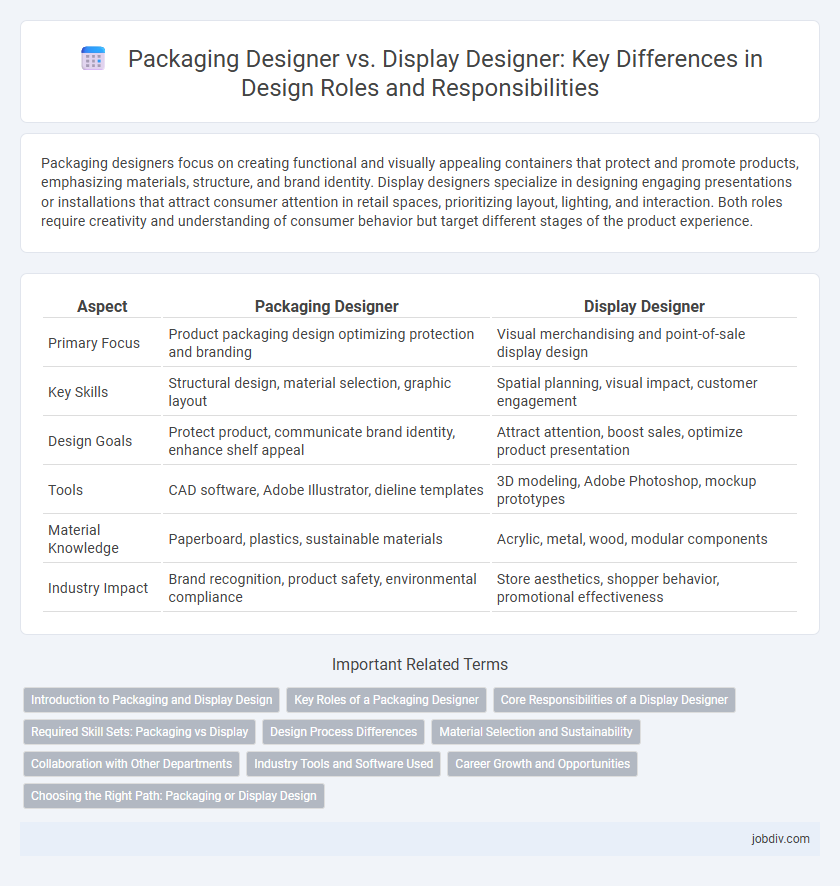Packaging designers focus on creating functional and visually appealing containers that protect and promote products, emphasizing materials, structure, and brand identity. Display designers specialize in designing engaging presentations or installations that attract consumer attention in retail spaces, prioritizing layout, lighting, and interaction. Both roles require creativity and understanding of consumer behavior but target different stages of the product experience.
Table of Comparison
| Aspect | Packaging Designer | Display Designer |
|---|---|---|
| Primary Focus | Product packaging design optimizing protection and branding | Visual merchandising and point-of-sale display design |
| Key Skills | Structural design, material selection, graphic layout | Spatial planning, visual impact, customer engagement |
| Design Goals | Protect product, communicate brand identity, enhance shelf appeal | Attract attention, boost sales, optimize product presentation |
| Tools | CAD software, Adobe Illustrator, dieline templates | 3D modeling, Adobe Photoshop, mockup prototypes |
| Material Knowledge | Paperboard, plastics, sustainable materials | Acrylic, metal, wood, modular components |
| Industry Impact | Brand recognition, product safety, environmental compliance | Store aesthetics, shopper behavior, promotional effectiveness |
Introduction to Packaging and Display Design
Packaging design focuses on creating protective, functional, and visually appealing containers that enhance product safety and brand identity. Display design emphasizes crafting engaging, strategic presentations in retail environments to attract customers and boost product visibility. Both disciplines blend creativity and marketing principles to influence consumer behavior through physical interaction and visual impact.
Key Roles of a Packaging Designer
Packaging designers specialize in creating functional and aesthetically appealing containers that protect products and enhance brand identity on retail shelves. They focus on material selection, structural integrity, and compliance with industry regulations to ensure packaging is practical and sustainable. Their role also involves collaborating with marketing teams to develop designs that attract consumers and communicate product information clearly.
Core Responsibilities of a Display Designer
Display designers primarily focus on creating visually appealing in-store exhibits, window displays, and promotional setups that enhance product visibility and attract customer attention. Their core responsibilities include conceptualizing and executing display themes, selecting appropriate materials, and collaborating with marketing teams to align displays with brand strategy. Unlike packaging designers who optimize product packaging for protection and branding, display designers emphasize spatial arrangement and aesthetic impact within retail environments.
Required Skill Sets: Packaging vs Display
Packaging designers require expertise in material science, structural design, and brand communication to create functional and visually appealing product containers that ensure protection and aesthetics. Display designers prioritize spatial design, visual merchandising, and user experience skills to develop engaging installations that attract consumer attention and enhance product visibility in retail environments. Mastery of CAD software is essential for packaging design, while display designers often rely on 3D modeling and fabrication techniques to bring concepts to life.
Design Process Differences
Packaging designers concentrate on creating functional and visually appealing product containers, emphasizing material selection, structural integrity, and brand messaging to ensure product protection and consumer engagement. Display designers focus on crafting in-store or event installations that highlight products through spatial arrangement, lighting, and interactive elements, aiming to maximize visibility and customer interaction. The design process for packaging involves prototyping physical durability and shelf impact, while display design prioritizes spatial experience and adaptability within retail environments.
Material Selection and Sustainability
Packaging designers prioritize selecting sustainable materials that reduce environmental impact while ensuring product protection and aesthetic appeal, often opting for recyclable or biodegradable options like kraft paper and PLA bioplastics. Display designers focus on durable, reusable materials such as aluminum or tempered glass to create visually striking structures that withstand repeated use in retail environments. Both roles demand expertise in eco-friendly practices but differ in balancing single-use packaging materials versus long-lasting display components for sustainability.
Collaboration with Other Departments
Packaging designers collaborate closely with marketing teams to ensure brand messaging is effectively conveyed through packaging visuals and materials. Display designers work hand-in-hand with sales and retail departments to create visually appealing product presentations that drive customer engagement. Both roles require seamless communication with production and supply chain teams to balance creative vision with manufacturing feasibility and cost constraints.
Industry Tools and Software Used
Packaging designers primarily use Adobe Illustrator and ArtiosCAD to create detailed dielines and 3D mockups essential for product packaging development. Display designers rely heavily on SketchUp and AutoCAD for spatial visualization and structural design of in-store displays and trade show booths. Both roles increasingly integrate Adobe Photoshop and 3D rendering tools like Blender to enhance visual presentation and prototype realism.
Career Growth and Opportunities
Packaging designers specialize in creating functional and visually appealing product packaging, leveraging skills in materials, branding, and sustainability, which opens career paths in consumer goods, retail, and marketing sectors. Display designers focus on designing engaging visual presentations and environments for exhibitions, retail spaces, and events, offering opportunities in experiential marketing, event planning, and visual merchandising. Career growth for packaging designers often leads to roles in product development and brand strategy, while display designers can advance to creative direction and project management within retail and advertising industries.
Choosing the Right Path: Packaging or Display Design
Packaging designers specialize in creating functional and visually appealing containers that protect products and enhance brand identity, focusing on materials, shape, and user experience. Display designers concentrate on crafting eye-catching promotional setups that attract customers and maximize product visibility in retail environments, emphasizing spatial arrangement and visual hierarchy. Choosing the right path depends on whether you prefer working with product protection and branding (packaging) or visual merchandising and spatial design (display).
Packaging Designer vs Display Designer Infographic

 jobdiv.com
jobdiv.com